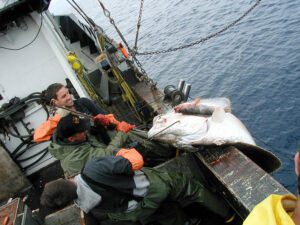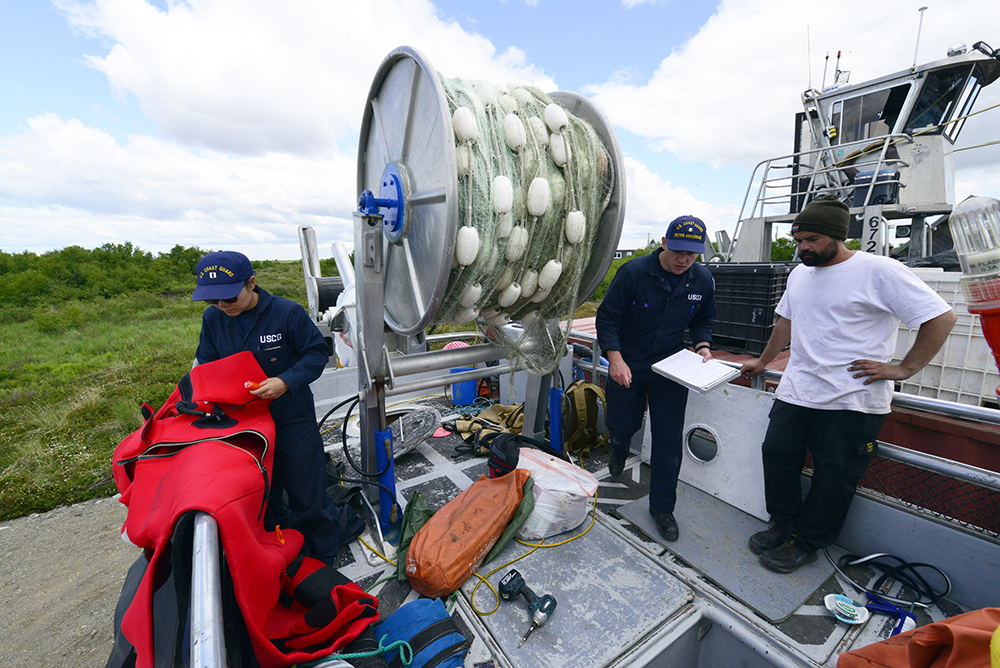
Commercial fishing vessels are built to withstand rough conditions and last for generations, but regular maintenance and upkeep are crucial to keeping them in tip-top shape. It’s particularly important to inspect a boat and its equipment prior to the fishing season after the vessel has been sitting idle for a stretch of time.
The same goes for the crew. While you’ll be hard-pressed to find tougher workers than in the commercial fishing industry, the job is demanding, strenuous and dangerous. It can take a toll on even the hardiest of mariners. Being up to date with safety training and ensuring safety equipment is in good-working condition can mean the difference between life and death out on the water.
It’s also important to ensure all inspections are completed and permits are in order and approved by the appropriate agencies. Don’t let paperwork delay you when timeliness is of the essence.
Before shoving off to sea, both crew and craft need to be properly prepared. And with that in mind, Fishermen’s News checked around for top tips regarding safety measures, crew care and equipment maintenance.
Tips & Advice
General tips include checking bilge pumps and alarm systems; testing any communication, computer and camera systems; greasing shafts and bearings; looking for leaks or cracks in hosing, and assessing the readiness of safety equipment.
Jack Wall, president of Al Larson Boat Shop near Los Angeles, had a single, direct message for mariners preparing for the upcoming 2023 season.
“I have only one comment to the commercial fisherman: Grease your shaft bearings, because the bearing replacement may be hard to find because of supply-chain issues,” Wall said.
Doug Dixon, general manager of Pacific Fishermen Shipyard, which has been servicing commercial vessels since 1946 in Ballard’s Salmon Bay in Seattle, had one very specific maintenance item commercial fishers should inspect before heading out.
“Bilge check valves are the most overlooked item that can literally sink you,” Dixon told Fishermen’s News. It’s a maintenance job some might feel queasy about doing, particularly if there’s not a drydock or diver nearby, but it will prove whether or not your boat is an “accident waiting to happen and whether your last surveyor was doing his job.”
Dixon explained the entire process to check.
“Dockside, shut down all your engines and go quiet on shore power. Open up all your sea chest valves,” he stated. “Now, without turning on any pumps, open up your engine room bilge suction valve, shaft alley bilge suction valve and lazarette bilge suction valve.”
“If you’re a crabber, you may have an emergency bilge suction off your crab manifold,” he continued. “Open it and the associated sea chest as well. If you’re a RSW seiner, trawler or salmon tender you may have an emergency bilge suction valve off of your RSW manifold. Open it too, and all the valves between your manifold and your seachest.”
“Now listen for running water. If you hear any, hopefully you can close your sea chest and suction valves to effect repairs,” he continued. “If not and you can’t get your sea suctions to close tight, send that diver overboard to plug your sea chest, or drive straight to your favorite drydock. Leaky sea chest valves are often a problem as well. You have discovered that: A) Your check valves are leaking, or B) They were never installed and you are missing these critical check valves entirely.”
“Some of you unfortunate souls,” Dixon concluded, “will find that there never was a check valve designed or installed in the system.”

Preventative Maintenance
Tim Cooper, head of Marine Group Boat Works’ technical team, said that keeping up with maintenance needs can help commercial fishermen save money, time and help prevent disaster from befalling the boat.
Marine Group Boat Works, a family-owned waterfront shipyard in San Diego, is home to a 665-ton travelift, extensive lifting mechanisms and a robust team of craftsmen and women specializing in a variety of trades, including welding, shipfitting, pipefitting, coatings, equipment rigging, mechanical and electrical.
The company services an average of 600 vessels every year (commercial, private and government customers), with about 15% being long range or commercial fishing boats.
Fish boats typically come in for routine maintenance, while a few have had to activate emergency haul outs, Cooper explained.
“Emergency haul outs are costly and can take precious time away from the owner’s time to be out fishing,” he said. “Exercising good maintenance practices can not only ensure a timelier yard period for routine haul-outs, but could also prevent the dreaded emergency ones.”
Among Cooper’s suggestions for what owners and crew can do to avoid a costly yard period:
- Check skin valve operation by rotating the handles to verify valves are not frozen. Grease valves if they have grease points.
- Look for salt creep or evidence of corrosion around the valves and flanges to verify there is no underlying evidence of potential issues.
- Make sure that all major machinery components (engines, hydraulics, etc.) have been serviced according to the original equipment manufacturer (OEM) service-hour specs.
- Apply grease to all grease points (seals, cylinders, etc.). Properly greased mechanical components have much longer life expectancy than non-serviced components.
- Apply fresh coat of bottom paint before extended expeditions.
- Make sure all life-saving apparatus (LSA) safety equipment is serviced and up to date per manufacturer/USCG/class specifications.
According to Giddings Boatworks, properly scheduled maintenance can help extend the life of a vessel during the fishing season and beyond. Based out of Charleston, Ore., the shipyard has been building and repairing commercial fishing vessels since 1979.
Regular inspections allow vessel owners to identify and fix problems in dry dock so they don’t have to deal with them at sea during the fishing season.
“Having your fishing boat breakdown during the fishing season only compounds your losses in revenue,” the Giddings Boatworks website notes. “We encourage vessel owners to prepare a work plan to maximize time spent out of the water.”
If maintenance is put off for too long, or it’s not addressed until something breaks, that could mean being forced to dock during peak operational times.

Maintaining Electronics
While inspecting the mechanical workings of the vessel, don’t forget about the technology.
Seatronx, a Las Vegas-based manufacturer and distributor of rugged electronics catering specifically to the military, maritime and industrial markets, notes that depending on the season, heat or cold weather can wreak havoc on marine electronics if they aren’t properly maintained.
Cleaning the interior and exterior of the boat, examining equipment for damage and maintaining marine electronics are all part of preparing a vessel.
On the company’s website, Seatronx officials advise mariners to prepare their vessels for the season ahead and ensure all electronics, engines and systems are working as they should.
The checklist should include:
- Checking the exterior of the boat for any cracks or blisters.
- Inspecting the engine and checking the oil and filter.
- Replacing windshield wipers if needed.
- Inspecting antennas, and ensuring they are correctly mounted.
- Ensuring all electronics are running correctly; this includes GPS, camera systems, chart plotters, computers and other marine electronics.
- Wiping down display screens to remove any dust or debris from storage.
- Checking for any damaged or corroded cables or wires, and replacing them if needed.
- Reconnecting your battery if you disconnected it during the winter, and checking for any corrosion.
- Updating software and data for your electronic charts and maps.

Safety Drills
Before shoving off for the season, it’s just as important to ensure that the crew completes certain safety drills and knows what all the safety equipment is and how to use it.
Jerry Dzugan, longtime director of the Alaska Marine Safety Education Organization, emphasized the importance of crew health and safety preparations. He recommends that crews on commercial fishing vessels practice monthly emergency safety drills.
“Since 1991, these monthly drills need to be done by someone trained in a USCG accepted Drill Conductor (DC) course,” he said.
A provision passed by Congress in 2010, but not enforced because it wasn’t written into a Code of Federal Regulations, states that DC refresher training should be taken every five years, Dzugan pointed out. It also states that training should include stability, navigation, weather, flooding control, firefighting and prevention, collision prevention, seamanship and personal survival and emergency drills. Some of these topics are covered in the DC training.
CPR and first zid certification are required on some commercial fishing vessels with three or more crew members. These usually have to be taken every two years.
First aid equipment is required to be consistent with the number of people onboard. It’s also a good idea to check prior to the start of the season for outdated medicines and replace items as needed.
“Even though some of these training requirements are not enforceable with a ‘ticket’ and fine, what happens in a casualty (event) and the resultant lawsuit, is that a civil court can find someone culpable for not following the law, even if it’s not being enforced,” Dzugan explained.
Proper Exercise
There’s no question that commercial fishing is a physically demanding job, but using proper form when working and keeping up with appropriate exercises can improve job performance and ensure you’re healthy to return for another season.
“Commercial fishing is a contact sport that is athletic in nature,” Dzugan said. “Keeping your body in tune throughout the year helps you be more productive with less pain and medical expenses.”
The areas most affected are backs, shoulders, wrists, hands and sometimes elbows, he noted.
“The greatest single source of injuries in commercial fishing are muscular-skeletal disorders,” Dzugan said, like strains, sprains, tendonitis, carpal tunnel, etc. “Most of these are chronic, not acute injuries, that build up over time and limit fishing time, loss of mobility, create pain and medical expense, shorten fishing times and work lifespan.”
The best way to prepare is stretching and strength training year-round, he suggested, adding that mariners also should consider adjusting the layout of their vessel to be more in tune with their body.
“Place fish cleaning surfaces at the proper height; use or design fish cleaning tools that put the bend in the tool, not your wrist; adopt better lifting postures, (and) switch work duties to avoid repetitive motions,” Dzugan advised.
He also emphasized the importance of getting enough sleep.
“Sleep deprivation is prevalent in many fisheries,” he said. “This leads to lower quality decision making, more errors in judgment and negatively affects every health factor as well as emotional and mental health.”
Don’t skimp on sleep, he said, or the number of crew members needed to do the work.
“Ask yourself, ‘what is the improvement you can make to decrease a risk on your vessel?’ Install a crew aboard rescue device for a quick recovery; change how you handle fish to reduce unneeded handling of fish and effort, while at the same time increasing the quality of your product; provide wearable, appropriate PFDs (personal flotation devices) for your crew,” Dzugan recommended.
“Don’t ask your vessel to do something that it wasn’t designed for,” he continued. “Keep your hull watertight. Get a dewatering pump. Take a stability class (stability and flooding are responsible for about 50% of all FV fatalities). Eat healthy when on the vessel and when off it. Keep a Narcan kit onboard, if not needed for your crew, then your own neighbor’s crew.”
“Stretch, sleep, fish, repeat,” Dzugan concluded.

Gear and Vessel Readiness
Getting ready for the fishing season includes readiness at multiple levels, Fish Safe BC Program Coordinator John Krgovich told Fishermen’s News, and vessel readiness, including maintenance, is perhaps the likeliest level fishermen look after.
Fish Safe BC, a public safety office in British Columbia, considers other levels of preparedness – gear readiness, and the associated maintenance and administrative readiness, including licensing, quotas, insurance and certification.
“Safety readiness is arguably the most important (part) of the pre-season preparation,” Krgovich said.
There are basically three components to pre-season safety readiness: Putting safe-work procedures in place, ensuring safety equipment is in good working order and having an emergency plan. Safe work procedures on the vessel can ensure that everyone comes home.
“We can organize these procedures by looking at the vessel, and work done on that vessel, and asking ourselves ‘what could kill me?’ or ‘what might hurt me?’” Krgovich explained. “An experienced fishermen will be able to answer those questions, so the next question is ‘what do you do to prevent this from happening’?”
These answers lay the basic groundwork for safe work procedures on a vessel, he added. The procedures need to be communicated to the crew prior to the fishing season. Writing these procedures down is a good idea and, in some jurisdictions, mandatory by regulation.
Second, commercial fishermen need to ensure they have all the needed safety equipment in place, and that it is all maintained.
“We can do this by going over all the safety equipment on our vessels with the crew pre-season and ensure they know where it is, how it’s used and how to maintain it throughout the season,” Krgovich said.
There are a number of items on the checklist, including expiration dates on items such as flares, hydrostatic release units and CO2 cartridges on inflatable PFDs.
It’s also important to check that fire extinguishers and life rafts have been serviced and reinstalled correctly. The inspection should include double checking that test pumps, alarms and emergency position indicating radio beacons are in proper working order. Immersion suits also need to be inspected, zippers waxed, and tried on.
It’s also a good idea to see that there’s an MMSI number installed on the DSC-VHF radios and that those radios are interfaced with a GPS to ensure they work correctly, in case of a distress situation, Krgovich advised.
The third component in pre-season safety preparedness is ensuring that an emergency plan is in place and that the captain and crew have practiced it.
“Yes, safety procedures should prevent an emergency, but history tells us, stuff happens,” Krgovich said. “And if there is an emergency, most fishermen will say the outcome of an emergency should be better if you plan and prepare for that emergency should it happen.”
Putting an emergency plan in place does not need to be a complicated task, he added.
“If a fisherman looks at emergency situations and asks himself ‘what if?’ then he will usually be able to understand the things that need to be done to (for example) put a fire out, retrieve a man overboard or deal with a flooding vessel,” Krgovich said. “Once these things are understood, then these duties are then assigned to the crew and written down.”

Once an emergency plan in place, it’s important to practice that plan with the crew. Conducting emergency drills will get the crew familiar with their duties and emergency equipment, as well as expose any potential problems with the plan. If an issue arises, there’s time to alter the plan so it fits you and your crew’s needs.
“By going through these three steps with the crew preseason—1) ensuring there are safe work procedures onboard and (that they are) understood; 2) doing a familiarization of all safety equipment including equipment use, location and maintenance, and 3) having an emergency plan in place which has been practiced—(goes) a long way in ensuring all fishermen come home safely,” Krgovich said.
Port of Seattle spokesperson Jenn Banday wrote a guide last June detailing how safe fishing starts with practice and preparation.
Fishers out of the North Pacific Fleet based out of Fishermen’s Terminal spend most of May and early June preparing their boats, provisioning, mending nets and brushing up on safety best practices.
Banday described some of the demonstrations presented at the 2022 Fishermen’s Memorial Safety Fair, including proper flare use, handling and storage, an interactive example on how to plug leaks fast using common items found onboard, expert explanations of common sources of onboard fires (mostly electrical issues or kitchen accidents) and the appropriate fire extinguisher for each situation, and “gumby suit,” or cold water immersion suit, training.
According to a commercial fishing safety report from the National Institute for Occupational Safety and Health, there were 115 commercial fishing fatalities on the West Coast while on the job between 2000-2014. The majority of fatalities occurred after a vessel disaster, while the second leading cause of death was falling overboard.
More than 200 commercial and recreational fishers died from falling overboard between 2000-2016 in the U.S. None were wearing a life jacket and in 59% of the falls there were no witnesses.
Checklist
Another arm of preparation: paperwork. Administratively, commercial fishers will want to be absolutely sure they have the proper permits and safety inspections completed well before the start of the season.
The Coast Guard provides the online commercial fishing vessel checklist generator to assist vessel owners/operators in their preparations prior to the USCG examination.
Using a desktop computer, laptop, tablet or smart phone, simply answer questions and the tool will generate a custom checklist of items required for your particular fishing vessel. Questions include vessel length, maximum crew onboard, systems installed on the vessel, primary means of propulsion and where it operates.
“Our primary goal in providing this service to the fishing fleet is to promote safety and prevent loss of life at sea,” Coast Guard Sector Anchorage fishing vessel safety examiner Chief Petty Officer David Schaeffer said. “(Fishermen) have one of the most dangerous jobs in the country, so our job is to make sure they’re prepared before heading out to sea.”
Sara Hall has 15 years of experience at several regional and national magazines, online news outlets, and daily and weekly newspapers, where coverage has included reporting on local harbor activities, marine-based news, and regional and state coastal agencies. Her work has included photography, writing, design and layout.
